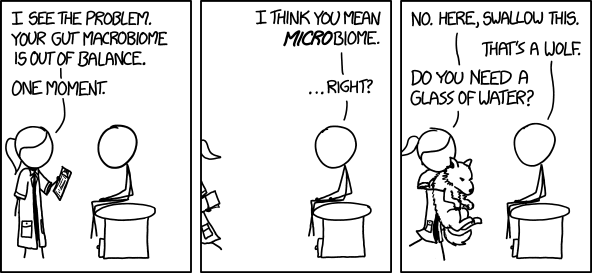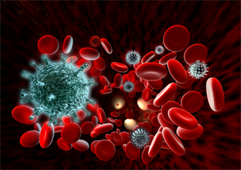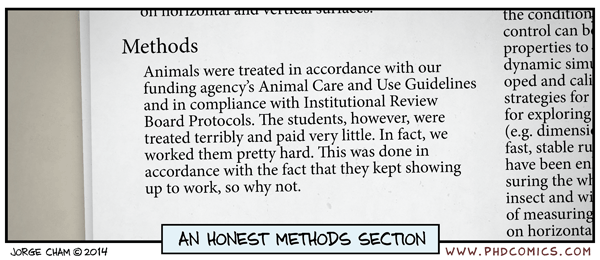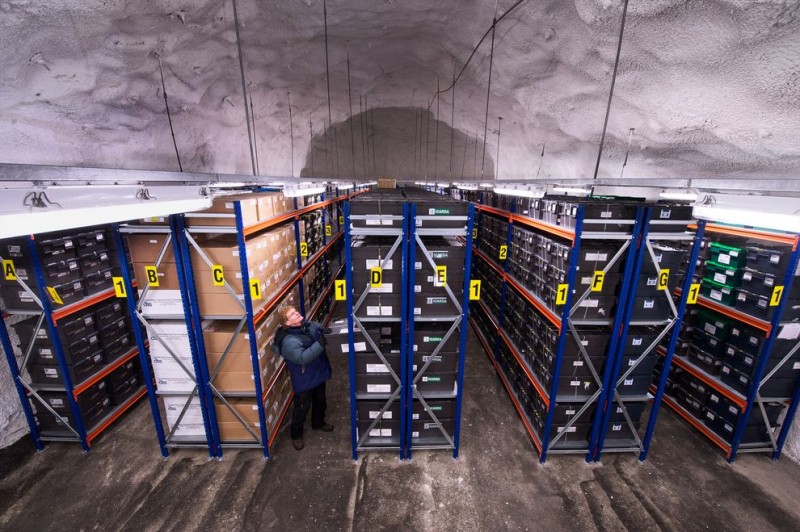I know I personally kept saying “I don’t wanna” throughout my master’s degree.
Tag: science
Gut macrobiome

With all of the talk on the media about the impact of gut microbiome on health, this XKCD comic really hits the spot :)
Scientists Have Discovered How Common Different Sexual Fantasies Are
We all have at least one, and most of us have many: Sexual fantasies. In fact, it’s normal, and even healthy, to have sexual fantasies.
What might not be normal is the type of sexual fantasy you’re daydreaming over. A new study is helping shed light on which sexual fantasies are prevalent and which are unusual and rare. Until recently, scientists had limited data on what constituted a normal sexual fantasy versus an unusual one, and most surveys that had explored this sensitive territory had surveyed only university students. But a big new data set has changed that.
To find out once and for all what the general population thinks about, a team of scientists at the University of Montreal in Quebec, Canada, straight up asked 1,517 adults residing in Quebec about their sexual fantasies. They published their findings on Friday in the Journal of Sexual Medicine.
“Clinically, we know what pathological sexual fantasies are: they involve non-consenting partners, they include pain, or they are absolutely necessary in deriving satisfaction,” lead author Christian Joyal said in a statement released by the university. “But apart from that, what exactly are abnormal or atypical fantasies?”
The team conducted an internet survey with 799 women and 717 men, where the mean age of the subjects was 30 years. Of the sample, 85.1% said they were heterosexual, 3.6% said they were definitely homosexual, and the rest were in between. The survey involved 55 statements that probed the nature and intensity of the subject’s sexual fantasies. The subjects rated each statement on a scale of 1 to 7, with 7 meaning they had experienced a very intense fantasy about what was described in the statement and 1 meaning they had not felt any intensity at all for that fantasy.
Here are some examples of the statements they answered:
- I have fantasized about having sex with an unknown person.
- I have fantasized about petting with a total stranger in a public place (e.g., metro).
- I have fantasized about being forced to have sex.
- I have fantasized about having sex with an animal.
- I have fantasized about having anal sex.
The full 55 are at the end of this post, along with how often they show up in the population questioned.
The team also asked the volunteers to describe, in detail, their favourite sexual fantasy if it was not included in the survey. After what must have been some very interesting reading, the team found that the men had more fantasies and described their favourite fantasy more vividly than the women did. Also, men expressed a stronger desire to make their fantasies a reality.
More women fantasized about having sex in a specific location while far more men fantasized about receiving oral sex. Interestingly, both sexes were about equal when it came to participating in group sex, although more men reported wanting to have an active versus passive role during group sex.
When it came to whom the subjects thought about, men reported fantasizing more about people they were not currently involved with. Of particular interest to the researchers was the high number of fantasies that were mostly unique to men, for example, fantasizing about anal sex and watching their partner have sex with another man.
“Evolutionary biological theories cannot explain these fantasies,” Joyal said in a release issued by the university.
After analyzing the data set as a whole, the team created a glossary defining certain “rare,” “unusual,” and “typical” sex fantasies. Rare meant that 2.3% or less of individuals reported this fantasy. Unusual meant 15.9% or less reported having them. Common fantasies meant they were shared by between 50% and 84.1% of individuals, and typical fantasies are common among more than 84.1% of the surveyed population.
Here are a few examples of what the researchers found in each of these categories:
Rare: sex with a child or animal
Unusual: “golden showers,” cross-dressing, sex with a prostitute, abusing an intoxicated person
Typical: sex in a romantic location, receiving oral sex, sex with two women (primarily a male fantasy)
The team isn’t done with its precious dataset, however. The researchers are now analyzing subgroups of fantasies to see which types of fantasies are common among the same people. For example, people who reported submission fantasies also described domination fantasies, which indicates that these two themes are connected.
Here’s the full table of the researchers’ findings. Where do your fantasies fit in?
As a side note, I’d have said yes to just under half of the statements :)
When healthy eating leads to malnutrition
 Some doctors and registered dietitians say they are increasingly seeing people whose desire to eat pure or “clean” food—from raw vegans to those who cut out multiple major food sources such as gluten, dairy and sugar—becomes an all-consuming obsession and leads to ill health. In extreme cases, people will end up becoming malnourished.
Some doctors and registered dietitians say they are increasingly seeing people whose desire to eat pure or “clean” food—from raw vegans to those who cut out multiple major food sources such as gluten, dairy and sugar—becomes an all-consuming obsession and leads to ill health. In extreme cases, people will end up becoming malnourished.
Some experts refer to the condition as orthorexia nervosa, a little-researched disorder that doesn’t have an official diagnosis in the Diagnostic and Statistical Manual of Mental Disorders, or DSM, considered the bible of psychiatric illnesses. Often, individuals with orthorexia will exhibit symptoms of recognized conditions such as obsessive-compulsive disorder or end up losing unhealthy amounts of weight, similar to someone with anorexia.
“There are people who become malnourished, not because they’re restricting how much they eat, it’s what they’re choosing to eat,” said Thomas Dunn, a psychologist and psychology professor at the University of Northern Colorado in Greeley, Colo., and a co-author of the article. “It’s not that they’re doing it to get thin, they’re doing it to get healthy. It’s just sort of a mind-set where it gets taken to an extreme like what we see with other kinds of mental illness,” Dr. Dunn said.
Among the proposed criteria: an obsession with the quality and composition of meals to the extent that people may spend excessive amounts of time, say three or more hours a day, reading about and preparing specific types of food; and having feelings of guilt after eating unhealthy food. The preoccupation with such eating would have to either lead to nutritional imbalances or interfere with daily functional living to be considered orthorexia.
Some Diets That Might Leave Out Nutrients
DAIRY-FREE: Pro: Some people feel better when avoiding dairy even if aren’t truly allergic. Challenge: Make sure to get calcium, phosphorus and potassium from other foods.
RAW VEGAN: Pro: Plant-based diets are nutritious and are associated with lower rates of obesity and chronic disease. Challenge: Some vitamins, especially B12, are mostly in animal products. Cooking can make some nutrients more bio available.
JUICING DIETS, CLEANSES: Pro: If used short term to kick start eating more fruits and vegetables, this diet can be acceptable. Challenge: Juices aren’t nutritionally complete. And cleansing is a misnomer as your body is ‘cleansed’ by the kidneys, digestive tract and lungs.
GLUTEN-FREE: Pro: Gluten is a must avoid for people with an allergy. Those who are sensitive may find they feel much better. Challenge: A complete diet can be achieved with energy- and nutrient-rich foods such as non-wheat grains.
Sometimes other illnesses can lead to orthorexia. David Rakel, director of integrative medicine at the University of Wisconsin School of Medicine and Public Health, estimated that 10% to 15% of the patients who come in with food allergies and related problems develop an unhealthy fear of particular foods.
Nutritional therapy often involves elimination diets—stopping to eat certain foods to check if they are contributing to an inflammatory condition, Dr. Rakel said. Under the program, the foods are later gradually reintroduced, but some people continue to avoid them. “People are getting so strict with their health choices that they’re not getting the nutrients that they need,” he said.
“Someone on paper may be perfectly healthy and their blood work is great and their weight is fine but their behavior has become obsessive with food,” said Marjorie Nolan Cohn, a New York City-based dietitian and national spokeswoman for the Academy of Nutrition and Dietetics, a professional organization. A red flag is when someone’s eating habits are making them avoid social engagements, Ms. Cohn said. “They may not be able to go out to a restaurant with their friends because they don’t know what’s in the food or it’s not cooked in a certain way or what if it’s not organic olive oil?” she said.
NIH Finds Old Ricin, Other Forgotten Germs in Labs

The National Institutes of Health said it has uncovered a nearly century-old container of ricin and a handful of other forgotten samples of dangerous pathogens as it combs its laboratories for improperly stored hazardous materials. The agency began an intensive investigation of all its facilities after a scientist in July found vials of smallpox dating from the 1950s, along with other contagious viruses and bacteria that had been stored and forgotten in one lab on the NIH’s campus.
Friday, the NIH said in different facilities, it found small amounts of five improperly stored “select agents,” pathogens that must be registered and kept only in certain highly regulated laboratories. All were found in sealed and intact containers, with no evidence that they posed a safety risk to anyone in the labs or surrounding areas, the agency said in a memo to employees. All have been destroyed.
They included a bottle of ricin, a highly poisonous toxin, found in a box with microbes dating from 1914 and thought to be 85 to 100 years old, the memo said. The bottle was labeled as originally containing 5 grams, although NIH doesn’t know how much was left. Also discovered were samples listing pathogens that cause botulism, plague, tularemia and a rare tropical infection called melioidosis. These samples were in different labs, mostly in historical collections that scientists once routinely kept in the backs of freezers or on dusty shelves but that today require special handling.
Doctorate in Chocolate

Scientists and chocolate fans are being given the chance to indulge their sweet tooth by becoming a doctor of chocolate at Cambridge University.
A researcher is being sought for a PhD on chocolate by the Department of Chemical Engineering and Biotechnology.
The challenge is to stop chocolate melting in warm climates by studying the “fundamentals of heat-stable chocolate”.
Candidates wishing to study chocolate need to apply by 29 August.
The would-be doctor of chocolate will be expected “investigate the factors which allow chocolate, which has a melting point close to that of the human body, to remain solid and retain qualities sought by consumers when it is stored and sold in warm climates”.
The research project is “mainly experimental”, but will require good mathematical skills, the advertisement says.
http://www.bbc.com/news/uk-england-cambridgeshire-28787676
Honest scientific paper

Reminds me of the bad old days…
The Svalbard Global Seed Vault
Beer and whiskey lovers, raise a glass to the Svalbard Global Seed Vault, which has just taken in 20,000 new crop varieties—including 575 types of barley. The seeds, sourced from more than a hundred countries, arrived this week to coincide with the vault’s sixth birthday.
The Svalbard Global Seed Vault is a secure seedbank on the Norwegian island of Spitsbergen near Longyearbyen in the remote Arctic Svalbard archipelago, about 1,300 kilometres (810 mi) from the North Pole.

The seedbank is 120 metres inside a sandstone mountain on Spitsbergen Island, and employs robust security systems. Seeds are packaged in special four-ply packets and heat sealed to exclude moisture. Spitsbergen was considered ideal because it lacked tectonic activity and had permafrost, which aids preservation. Its being 130 metres above sea level will keep the site dry even if the ice caps melt. Locally mined coal provides power for refrigeration units that further cool the seeds to the internationally recommended standard of −18 °C. If the equipment fails, at least several weeks will elapse before the facility rises to the surrounding sandstone bedrock’s temperature of −3 °C. It’s also located in a politically stable and remote part of the world, which means that there are fewer hazards posed by messy humanity. And under international treaty, military activity is forbidden there.
As a “safety deposit box” to protect the diversity of the world’s food genes, the advanced facility houses 820,619 crop varieties. The goal of the vault is to safely preserve as many different varieties of crop species as possible before they disappear during large-scale regional or global crises. It will be also be frequently accessed when other genebanks lose samples due to mismanagement, accident, equipment failures, funding cuts, and natural disasters. These events occur with some regularity. War and civil strife have have a history of destroying some genebanks. Some 1,400 “crop diversity collections” exist globally, many in politically unstable or environmentally threatened nations.
As we’ve come to rely on just a handful of the highest yielding varieties of fruits, vegetables, and grains, thousands of other varieties are disappearing at an alarming rate. Given an uncertain future, with climate change and diseases that could wipe out a variety overnight, scientists say it’s important to keep as many different crop varieties as we can.
A feasibility study prior to construction determined that the vault could, for hundreds of years, preserve most major food crops’ seeds. Some, including those of important grains, could survive far longer—possibly thousands of years.
Here are a few highlights of the recent acquisition.

In the first ever seed deposit from Japan, the Barley Germplasm Center, located at Okayama University, sent in 575 types of barley, with plans to send another 5,000 in the future. Barley experts in the country became concerned about the stability of their gene banks following the 2011 Japanese earthquake and tsunami.
That’s because the grain is a staple of traditional Japanese cuisine. Barley is fermented to make beer, forms the base of miso soup, is roasted to make a cold tea called mugicha, and is distilled to make a Scotch-like whiskey. In 2010, Japanese brewer Sapporo made a limited-edition “space beer” with barley grown from seeds that spent five months in Russia’s Zvezda Service Module on the International Space Station.
Several of the nearly 200 species of wild potato growing from Patagonia all the way north to Colorado could go extinct by 2050 thanks to loss of habitat and climate change. That possibility has spurred the International Potato Center to action. The center shipped 195 samples of wild potato and 61 of wild sweet potato to Svalbard, in part to protect the species and to experiment with creating more nutritious, disease-resistant types of domestic potatoes.
Other “crown jewels of agriculture” are also new to the vault: The International Maize and Wheat Improvement Center mailed in 1,946 types of maize and 5,964 samples of wheat. Svalbard’s collection contains wheat seeds from individual villages throughout the world, which have baked their own unique breads through the centuries.
Brazilians eat black beans with almost every meal, and they’re an important ingredient in feijoada, a bean-and-pork stew that’s largely considered the South American country’s national dish. To protect these bean varieties for the future, the Brazilian Agricultural Research Corporation sent 514 samples to Svalbard.



